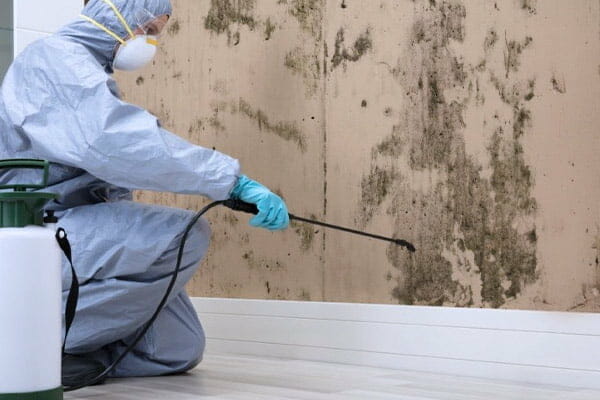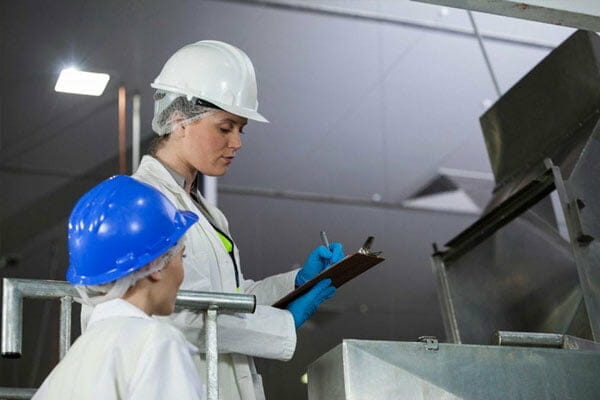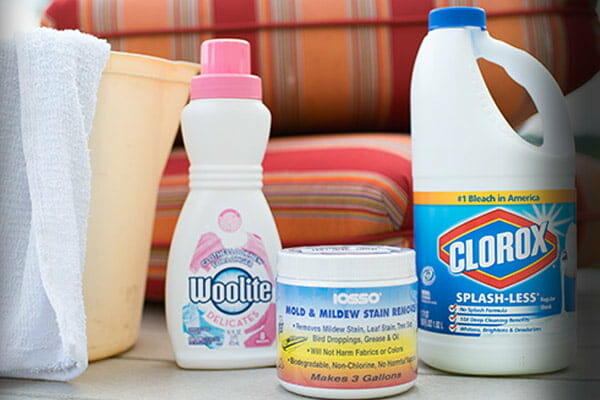Given the potential health hazards linked to the growth of mold, individuals who have discovered mold or mildew in their offices or warehouses should think about securing services for commercial mold remediation.
Commercial mold remediation involves the “removal, cleaning, sanitizing… or other treatment” of mold or moldy items. Commercial mold remediation is when this clean up is done on a large scale by specially trained and qualified professionals.
In this guide, we run you through the basics of commercial mold remediation, including the equipment and products used, the qualifications your mold remediators should have, the guidelines for remediating different mold growths, and how much commercial mold remediation will cost you.
What we cover
ToggleDo you need commercial mold remediation?

When faced with an invasion of mold or mildew, it can be tempting to call up the closest mold remediator and have them fix the issue for you. After all, mold is dangerous, isn’t it?
In large amounts, mold can certainly pose a danger to your health, particularly if you suffer from asthma or a mold allergy. Whether or not the mold in your home, school, or office is likely to be harmful and require commercial mold remediation will depend on the size of the mold growth and the type of mold that is growing.
The size of your mold growth
The general guidelines from the Environmental Protection Agency (EPA) state that if a mold growth measures more than ten square feet – approximately 3 feet by 3 feet – then you will need to call in professional commercial remediators.
If you suspect that your air ducts or air conditioning systems are afflicted with mold, then you can call in professional mold remediators to test for mold growth. If it is proven that mold is growing in these key air circulation systems, then you will need to have them professionally cleaned and remediated.
If you have a mold issue in a school, office, or other commercial building, the same ten square feet guidance applies. Given the increased risk to public health with mold growth in these buildings, however, it may be advisable to seek guidance from professional commercial mold remediators anyway.
The type of mold
When it comes to testing for the type of mold you have growing in your home, school, or office, it can be almost impossible to definitively categorize and identify one mold type from another.
Not only do most molds resemble each other closely when viewed with the naked eye, but many molds can differ in color, size, and texture within the same species. For instance, the infamous toxic black mold is not in fact black, but rather has a greenish-black hue that could prove misleading and potentially dangerous.
The only way to be certain of the identity of any type of mold is through a laboratory test. Many professional mold remediators will organize this testing for you as part of their services.
What is commercial mold testing?

Commercial mold testing is a comprehensive service that is usually conducted as part of any commercial mold remediation project. It goes far beyond simply testing for and identifying certain types of mold, and also includes testing for the location and extent of any mold infestation.
Although some mold growths might be easy to spot and smell, particularly if they are in highly frequented, open areas of your home, school, or office, other mold growths are much more difficult to locate. If you have mold growth behind drywall, underneath carpet, or in an attic or crawl space, it can go unnoticed for quite some time.
Commercial mold remediators will check all these areas of your building thoroughly if they suspect that you have a serious mold invasion in these hard-to-reach areas. These comprehensive inspections can take an entire day or even longer, depending on the size of your property.
Once the commercial mold remediators have identified the location of your mold growths, they will be able to determine the size and extent of these growths. This can be done through both a visual assessment and by testing the air for a mold spore count.
A mold spore count relates to the number of spores per square meter of air. While a mold spore count of 3000 spores per square meter is usually the point at which issues arise with most types of mold, other types of mold such as toxic black mold are considered dangerous in much lower quantities – even as low as 50 spores per square meter!
Although it is not strictly necessary, commercial mold remediators can also test for the type of mold you have growing on your property. The official guidance from the EPA states that any visible mold growths should be removed, regardless of type. Sometimes a commercial mold remediator will test for the type of mold in order to understand the best and safest remediation process.
Testing for mold type involves taking a physical sample and sending it to a specialized lab for identification. You can always ask your professional remediator for the results of these lab tests, especially if you think you have a recurring, stubborn mold problem.
What qualifications or certifications do commercial mold remediators need to have?
Although it is not legally required by every state, there are nationwide training and certifications available for commercial mold remediators.
The National Organization of Remediators and Mold Inspectors offers several certifications and training, from certifications for mold assessors and workers to training for environmental consultants. It is even possible to become certified in specific, highly specialized types of mold remediation, including such things as contaminated drywall assessment and remediation, and biocide application.
The Institute of Inspection Cleaning and Restoration Certification has also developed its own standalone certification for professional commercial mold remediators. Called the Mold Removal Specialist certification, this wide-ranging certification endorses mold remediators across a wide range of skills and capabilities. Some of these include the performance of mold remediation for both buildings and contents, containment protocols, principles of health and safety, and comprehensive knowledge of legal protocols and other relevant legislation.
Before you engage a professional commercial mold remediator, check what certification and licensing are required by your state. Even if your state does not require mold remediators to hold any specific licenses, you can still always ask to see the qualifications and certifications of any remediator you wish to engage.
Commercial mold products - how do they differ from residential mold products?

If you engage a professional mold remediator to clean and sanitize your home, they will use the same chemicals and equipment that they would use in any other type of building. The basics of mold remediation remain the same, irrespective of building size or usage.
If you wish to remove mold yourself, it is possible to do so with a few, common household cleaners. As per the EPA guidelines, the size of any moldy area suitable for self remediation is very small and can be dealt with fairly easily using products you probably already have at home.
To remediate a small, moldy area yourself, you will need the following:
- Basic protective equipment, including a mask, rubber gloves, eyewear, and sturdy covered shoes
- A stiff brush to remove any surface mold
- Household bleach
- Washing detergent
- Warm water
- Cloths, sponges, or other cleaning tools
When it comes to commercial mold remediation, however, the chemicals and equipment required are more extensive. As commercial mold remediators are exposed to greater quantities of mold for longer periods of time, they require specialized materials in order to ensure they are able to work safely and successfully remediate your property.
Although the specific products required for commercial mold remediation will differ depending on the extent and location of the mold growth, some of the more common chemicals and equipment used are:
- Full personal protective equipment, including disposable coverings for clothing and footwear and respirators
- Wet dry vacuums, which are are vacuum cleaners designed to collect water
- High powered fans and dehumidifiers
- Professional grade biocides used to kill mold growths
- Containment sprays, to reduce the dispersion of spores in the air
- HEPA vacuums, which will remove any fine particles or spores in the air
This list of products is not by any means extensive and doesn’t cover disposal and removal methods for any highly contaminated items that can not be remediated and need to be disposed of.
How much does commercial mold remediation cost?
The mold remediation cost for your property will depend upon the extent and size of the mold growth, whether the growth is in an easily accessible area, and the market rate of mold remediation in your local area.
Most mold remediators will charge between $10 and $25 per square foot for mold remediation. For an open, small, and easily accessible area such as a bathroom, laundry, or kitchen, this means your mold remediation could cost as little as $50.
However, if you have mold growing in larger, hard to reach spaces such as an attic, crawl space, or even behind your walls, you can expect this cost to increase correspondingly. For example, mold removal in a large, confined attic can cost as much as $7,000, especially if more extensive roof leakage repairs are required.
What are the EPA mold remediation guidelines for homes?
When it comes to removing mold in your home, the most important thing to remember is that you should only ever attempt self remediation on small mold growth, no larger than ten square feet in total.
Beyond this size guideline, the EPA advises that you first address any leaks or moisture issues that may be causing mold growth, ensure you are wearing adequate protective equipment when performing remediation work, and that you use the correct products to remove the mold.
If the mold growth is larger than the mandated ten square feet, then the same rules apply for mold remediation in your home as they would in any other type of property.
What are the EPA mold remediation guidelines for schools and businesses?
If the mold growth in question is larger than ten square feet, then the EPA advises that you seek the services of a professional commercial mold remediator.
One of the first and most crucial points remains the same as mold remediation in any other situation: identifying and fixing the dampness or moisture problem that has led to the mold growth in the first place.
Professional commercial remediators will be trained in how to do this, and will also be able to advise the best course for preventing any future dampness issues.
The official EPA guidelines for mold remediation in schools and commercial buildings differ slightly depending on the size and location of the mold growth, but are always focused on the four following factors:
- Identification: Identifying the source of the mold growth and the extent of the mold growth
- Containment: Containing the mold growth to prevent the spread of harmful mold spores
- Remediation: Fixing any dampness or moisture issues, drying the area, and cleaning and sanitization the mold affected materials
- Removal and disposal: Removal and disposal of any mold-infested materials that can not be remediated, and the disposal of any other products or items that were used during the remediation process
What should I do following commercial mold remediation?
Once commercial mold remediators have completed their remediation of your property, it is safe to resume your usual activities.
In order to keep your property free of mold in the long term, it is important to ensure that you do not allow any dampness or moisture issues to take root.
Whether this is regular maintenance of leaking pipes or rooves, or ensuring that you utilize a dehumidifier during the wetter, more humid months, keeping your property dry and well ventilated is one of the easiest and most certain ways to keep your home, school, or office free from future mold growths.













